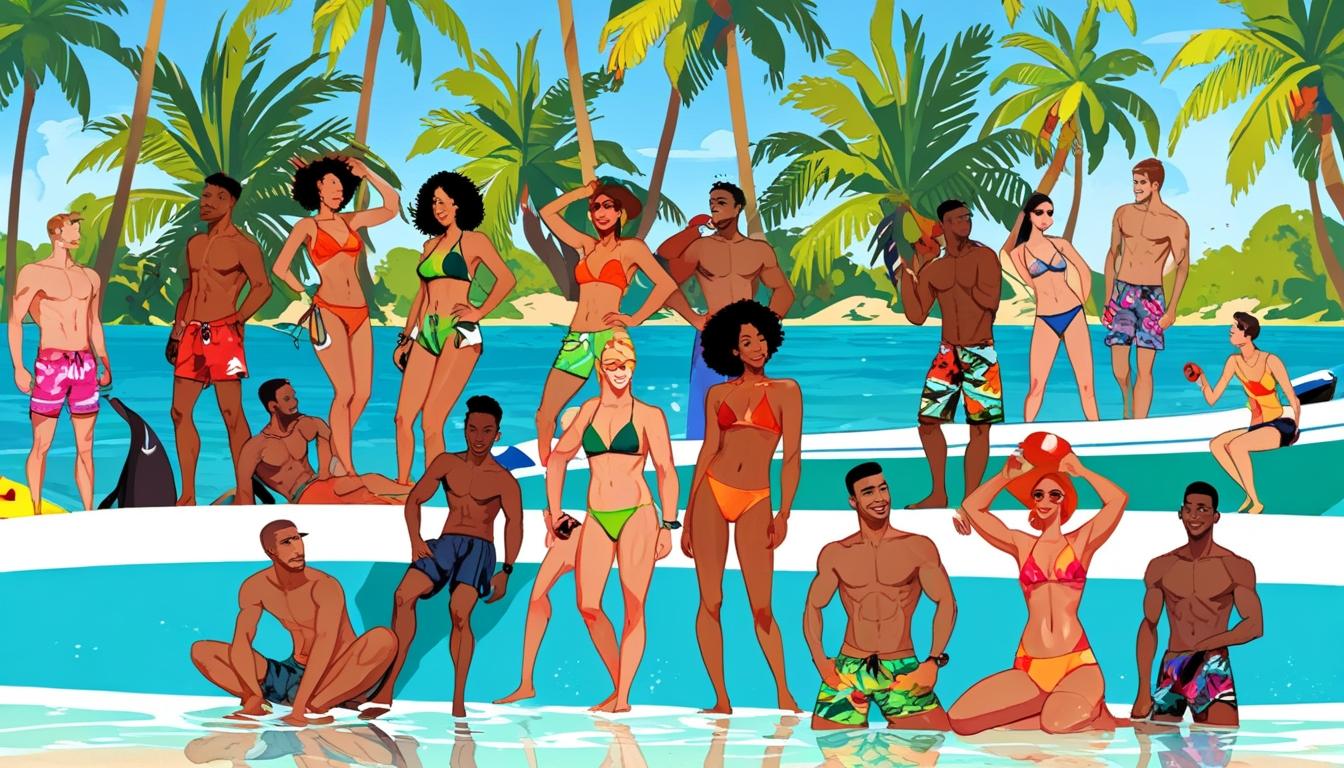The swimwear and beachwear market is projected to grow at a 6.1% CAGR to USD 42.3 billion by 2032, fueled by sustainable fashion trends, rising travel activities, and advancements in AI-driven retail experiences.
The global swimwear and beachwear market is projected to experience substantial growth in the coming decade, with a compound annual growth rate (CAGR) of 6.1%, reaching an estimated value of USD 42.3 billion by 2032. This forecast reflects burgeoning consumer interest driven by shifts towards sustainable fashion, growing travel and leisure activities, and evolving style preferences.
According to Persistence Market Research, the industry is expected to expand from an anticipated worth of USD 28 billion in 2025 to over USD 42 billion by the end of the decade. The Asia Pacific region is poised to lead this growth, projected to hold 37.2% of the global market share by 2025 due to its large population of young, trend-conscious consumers and rising disposable incomes in countries such as China and India. Popular beach destinations in this region, including the Maldives, Bali, and Thailand, also attract millions of tourists annually, sustaining demand for swimwear and related products.
Women’s swimwear dominates the sector, anticipated to account for approximately 73% of the market share in 2025. This segment’s growth is fueled by demand for trendy, functional designs that cater to a wide range of body types, supported by movements emphasizing body positivity. The market for children’s swimwear, covering boys, girls, and toddlers, is also growing as families increasingly prioritize beach vacations.
Material choices are evolving alongside consumer priorities, with polyester predicted to comprise 35.4% of material share by 2025. There is a marked consumer trend towards eco-friendly products made from recycled materials, including recycled polyester and nylon derived from ocean waste. Persistence Market Research highlights that sustainable practices are expected to become widespread, projecting that 70% of swimwear brands will incorporate sustainable collections by 2030, a significant increase from 40% in 2023.
The rise of digital tools is enhancing the consumer experience in both physical and online retail channels. Artificial intelligence (AI)-driven sizing recommendations and virtual try-on technologies are helping shoppers find personalized fits, improving convenience particularly in e-commerce platforms, which are seeing rising sales.
Market segmentation includes diverse product types such as one-piece suits, bikinis, tankinis, swim shorts, kaftans, rash guards, board shorts, and accessories like hats and footwear. Swim tops and shorts, prized for their versatility and comfort, are especially popular. The industry also responds to activity-driven demand, with increasing participation in water sports and fitness pursuits encouraging brands to develop swimwear with performance features like UV protection, chlorine resistance, and compression technologies.
The swimwear markets in North America and Europe remain significant, propelled particularly by tourism in summer months. In these regions, there is growing consumer interest in athleisure swimwear and modest swimwear that accommodates cultural or religious preferences. Additionally, rising participation by women in water sports is inspiring brands to expand inclusive and adaptive swimwear options, targeting broader demographic needs including individuals with disabilities.
Despite promising growth, the market faces challenges such as seasonality—with peak demand in warmer months leading to revenue fluctuations—and price sensitivity, which intensifies competition especially among mass-market players. Premium and sustainable swimwear options often grapple with balancing higher costs against consumer affordability.
Opportunities within the market include the expansion of athleisure swimwear, which appeals to consumers seeking versatile clothing for both water activities and casual wear. Celebrity collaborations and limited-edition collections have also gained traction, driving sales through exclusivity and social media influence. Niche segments such as maternity swimwear, modest swimwear, and adaptive swimwear address specific needs related to cultural, pregnancy-related, or accessibility concerns, representing additional growth areas.
Notable players in the swimwear market include Speedo International Limited, Nike, Inc., Rip Curl Group Pty Ltd., Arena S.p.A., and Seafolly. Recent developments include a licensing and distribution agreement between Li & Fund and Pendleton Woolen Mills initiated in November 2024 to launch a new swim and beachwear line. Additionally, in May 2024, Manushi Chillar introduced the brand Dweep, a celebrity-backed swimwear label.
The report from Persistence Market Research offers comprehensive insights into the evolving dynamics of the swimwear and beachwear market, highlighting how factors such as sustainability, customization, active lifestyles, and regional tourism patterns will shape the industry through 2032.
Source: Noah Wire Services





Great breakdown! Security starts with awareness, and it’s refreshing to see platforms like Sprunki Mods prioritize creativity with built-in safeguards. Always stay cautious but curious.
Reading about game strategy really highlights how crucial discipline is. A solid platform like og777 slot download can help, but bankroll management is key-even for VIP players! It’s about informed choices, not just luck.
Interesting points about bankroll management! Seeing platforms like ph978 casino vip emphasize KYC is good – security & compliance are key for long-term play. Responsible gaming is always a win!
This is such a valuable article! ? I really like how you’ve managed to explain the topic in a clear and practical way—it feels authentic and easy to relate to. Reading it gave me some new perspectives that I can actually apply. I’m especially interested in content like this because at meinestadtkleinanzeigen.de we’re running a classifieds and directory platform in Germany that connects people with services, businesses, and opportunities across many categories. Insights like yours remind me how powerful it is when knowledge and connections come together. Thanks for sharing—looking forward to more of your work! ?
Fantastic read! ? I really appreciate how clearly you explained the topic—your writing not only shows expertise but also makes the subject approachable for a wide audience. It’s rare to come across content that feels both insightful and practical at the same time. At explodingbrands.de we run a growing directory site in Germany that features businesses from many different categories. That’s why I truly value articles like yours, because they highlight how knowledge and visibility can create stronger connections between people, services, and opportunities.Keep up the great work—I’ll definitely be checking back for more of your insights! ?
Fantastic read! ? I really appreciate how clearly you explained the topic—your writing not only shows expertise but also makes the subject approachable for a wide audience. It’s rare to come across content that feels both insightful and practical at the same time. At explodingbrands.de we run a growing directory site in Germany that features businesses from many different categories. That’s why I truly value articles like yours, because they highlight how knowledge and visibility can create stronger connections between people, services, and opportunities.Keep up the great work—I’ll definitely be checking back for more of your insights! ?
Scratch cards always feel like a little burst of optimism, don’t they? It’s fun to think about instant wins! Speaking of easy access, I saw KKKJILI offers a smooth signup – check out the kkkjili app download for quick gaming! Seems super convenient with those local payment options too. ?
https://shorturl.fm/w55lM
I must say this article is extremely well written, insightful, and packed with valuable knowledge that shows the author’s deep expertise on the subject, and I truly appreciate the time and effort that has gone into creating such high-quality content because it is not only helpful but also inspiring for readers like me who are always looking for trustworthy resources online. Keep up the good work and write more. i am a follower.
Great article, thank you for sharing these insights! I’ve tested many methods for building backlinks, and what really worked for me was using AI-powered automation. With us, we can scale link building in a safe and efficient way. It’s amazing to see how much time this saves compared to manual outreach.
I must say this article is extremely well written, insightful, and packed with valuable knowledge that shows the author’s deep expertise on the subject, and I truly appreciate the time and effort that has gone into creating such high-quality content because it is not only helpful but also inspiring for readers like me who are always looking for trustworthy resources online. Keep up the good work and write more. i am a follower.
Great article, thank you for sharing these insights! I’ve tested many methods for building backlinks, and what really worked for me was using AI-powered automation. With us, we can scale link building in a safe and efficient way. It’s amazing to see how much time this saves compared to manual outreach.
**?mindvault**
mindvault is a premium cognitive support formula created for adults 45+. It’s thoughtfully designed to help maintain clear thinking
What a comprehensive overview.
Great article, thank you for sharing these insights! I’ve tested many methods for building backlinks, and what really worked for me was using AI-powered automation. With us, we can scale link building in a safe and efficient way. It’s amazing to see how much time this saves compared to manual outreach. https://seoexpertebamberg.de/
Great article, thank you for sharing these insights! I’ve tested many methods for building backlinks, and what really worked for me was using AI-powered automation. With us, we can scale link building in a safe and efficient way. It’s amazing to see how much time this saves compared to manual outreach. https://seoexpertebamberg.de/
I must say this article is extremely well written, insightful, and packed with valuable knowledge that shows the author’s deep expertise on the subject, and I truly appreciate the time and effort that has gone into creating such high-quality content because it is not only helpful but also inspiring for readers like me who are always looking for trustworthy resources online. Keep up the good work and write more. i am a follower. https://webdesignfreelancerfrankfurt.de/
**?prostadine**
prostadine is a next-generation prostate support formula designed to help maintain, restore, and enhance optimal male prostate performance.
I must say this article is extremely well written, insightful, and packed with valuable knowledge that shows the author’s deep expertise on the subject, and I truly appreciate the time and effort that has gone into creating such high-quality content because it is not only helpful but also inspiring for readers like me who are always looking for trustworthy resources online. Keep up the good work and write more. i am a follower. https://webdesignfreelancerfrankfurt.de/
**sugarmute**
sugarmute is a science-guided nutritional supplement created to help maintain balanced blood sugar while supporting steady energy and mental clarity.
**gl pro**
gl pro is a natural dietary supplement designed to promote balanced blood sugar levels and curb sugar cravings.
**?mitolyn**
mitolyn a nature-inspired supplement crafted to elevate metabolic activity and support sustainable weight management.
**zencortex**
zencortex contains only the natural ingredients that are effective in supporting incredible hearing naturally.
**?prodentim**
prodentim an advanced probiotic formulation designed to support exceptional oral hygiene while fortifying teeth and gums.
**vitta burn**
vitta burn is a liquid dietary supplement formulated to support healthy weight reduction by increasing metabolic rate, reducing hunger, and promoting fat loss.
**?yusleep**
yusleep is a gentle, nano-enhanced nightly blend designed to help you drift off quickly, stay asleep longer, and wake feeling clear.
**synaptigen**
synaptigen is a next-generation brain support supplement that blends natural nootropics, adaptogens
**nitric boost**
nitric boost is a dietary formula crafted to enhance vitality and promote overall well-being.
**glucore**
glucore is a nutritional supplement that is given to patients daily to assist in maintaining healthy blood sugar and metabolic rates.
**wildgut**
wildgutis a precision-crafted nutritional blend designed to nurture your dog’s digestive tract.
Great article! I really appreciate the clear insights you shared – it shows true expertise. As someone working in this field, I see the importance of strong web presence every day. That’s exactly what I do at https://webdesignfreelancerhamburg.de/ where I help businesses in Hamburg with modern, conversion-focused web design. Thanks for the valuable content!
Great article! I really appreciate the clear insights you shared – it shows true expertise. As someone working in this field, I see the importance of strong web presence every day. That’s exactly what I do at https://webdesignfreelancerhamburg.de/ where I help businesses in Hamburg with modern, conversion-focused web design. Thanks for the valuable content!
**?pinealxt**
pinealxt is a revolutionary supplement that promotes proper pineal gland function and energy levels to support healthy body function.
**energeia**
energeia is the first and only recipe that targets the root cause of stubborn belly fat and Deadly visceral fat.
**?boostaro**
boostaro is a specially crafted dietary supplement for men who want to elevate their overall health and vitality.
**?prostabliss**
prostabliss is a carefully developed dietary formula aimed at nurturing prostate vitality and improving urinary comfort.
**?breathe**
breathe is a plant-powered tincture crafted to promote lung performance and enhance your breathing quality.
**?potentstream**
potentstream is engineered to promote prostate well-being by counteracting the residue that can build up from hard-water minerals within the urinary tract.
**hepato burn**
hepato burn is a premium nutritional formula designed to enhance liver function, boost metabolism, and support natural fat breakdown.
Great article! I really appreciate the clear insights you shared – it shows true expertise. As someone working in this field, I see the importance of strong web presence every day. That’s exactly what I do at https://webdesignfreelancerhamburg.de/ where I help businesses in Hamburg with modern, conversion-focused web design. Thanks for the valuable content!
**hepatoburn**
hepatoburn is a potent, plant-based formula created to promote optimal liver performance and naturally stimulate fat-burning mechanisms.
**?cellufend**
cellufend is a natural supplement developed to support balanced blood sugar levels through a blend of botanical extracts and essential nutrients.
**prodentim**
prodentim is a forward-thinking oral wellness blend crafted to nurture and maintain a balanced mouth microbiome.
**?flowforce max**
flowforce max delivers a forward-thinking, plant-focused way to support prostate health—while also helping maintain everyday energy, libido, and overall vitality.
**?revitag**
revitag is a daily skin-support formula created to promote a healthy complexion and visibly diminish the appearance of skin tags.
**?neurogenica**
neurogenica is a dietary supplement formulated to support nerve health and ease discomfort associated with neuropathy.
**sleep lean**
sleeplean is a US-trusted, naturally focused nighttime support formula that helps your body burn fat while you rest.
Great article! I really appreciate the clear insights you shared – it shows true expertise. As someone working in this field, I see the importance of strong web presence every day. That’s exactly what I do at https://webdesignfreelancerhamburg.de/ where I help businesses in Hamburg with modern, conversion-focused web design. Thanks for the valuable content!
**memorylift**
memorylift is an innovative dietary formula designed to naturally nurture brain wellness and sharpen cognitive performance.
Great article! I really appreciate the clear insights you shared – it shows true expertise. As someone working in this field, I see the importance of strong web presence every day. That’s exactly what I do at https://webdesignfreelancerhamburg.de/ where I help businesses in Hamburg with modern, conversion-focused web design. Thanks for the valuable content!
Been playing on h2betcasino for a bit now. The live casino games are pretty good, especially if you like that real dealer experience. Not the flashiest casino out there, but reliable. Check them out here: h2betcasino
Tried to find somethin’ on top646ph, and I gotta say, not bad! Seemed easy enough for quick searching. Always good to have handy top646ph
Alright, gojackpot88login is pretty smooth. Logged in quick, played a few rounds, and no complaints. Website is easy to navigate, which is always a plus. Worth checking out at gojackpot88login if you’re hunting for jackpots.